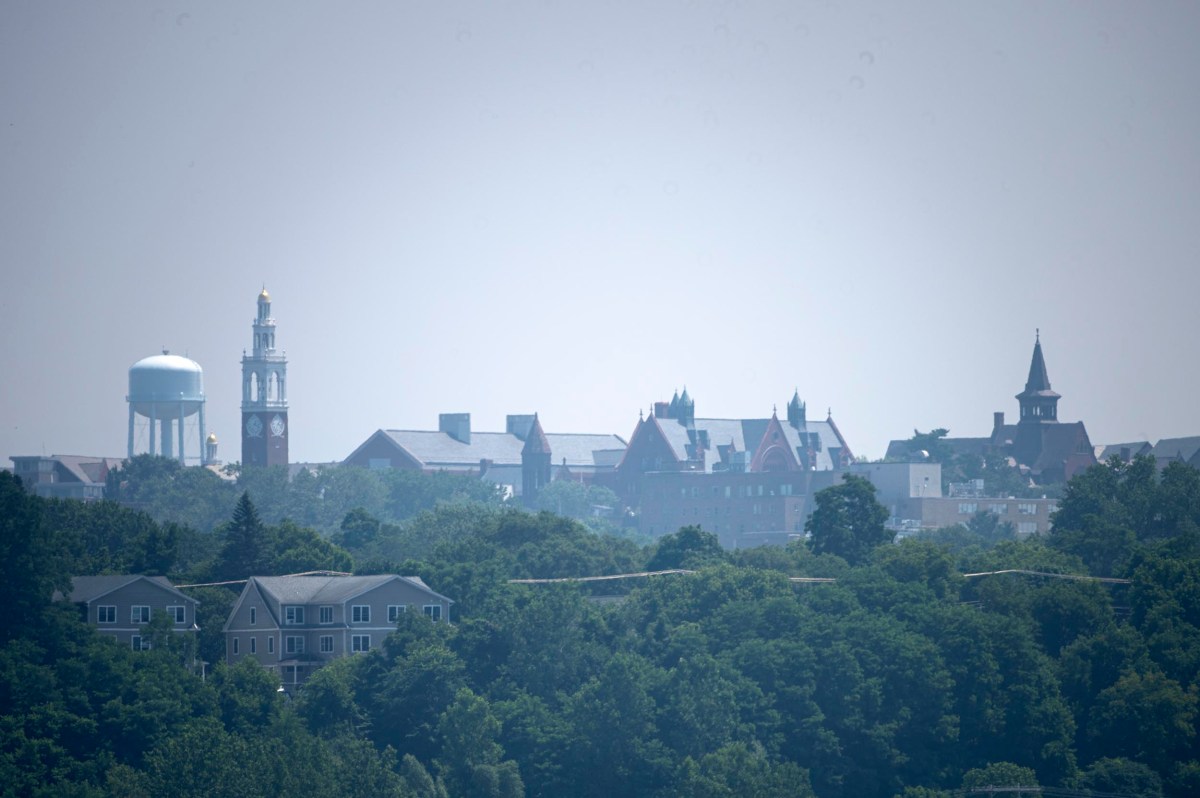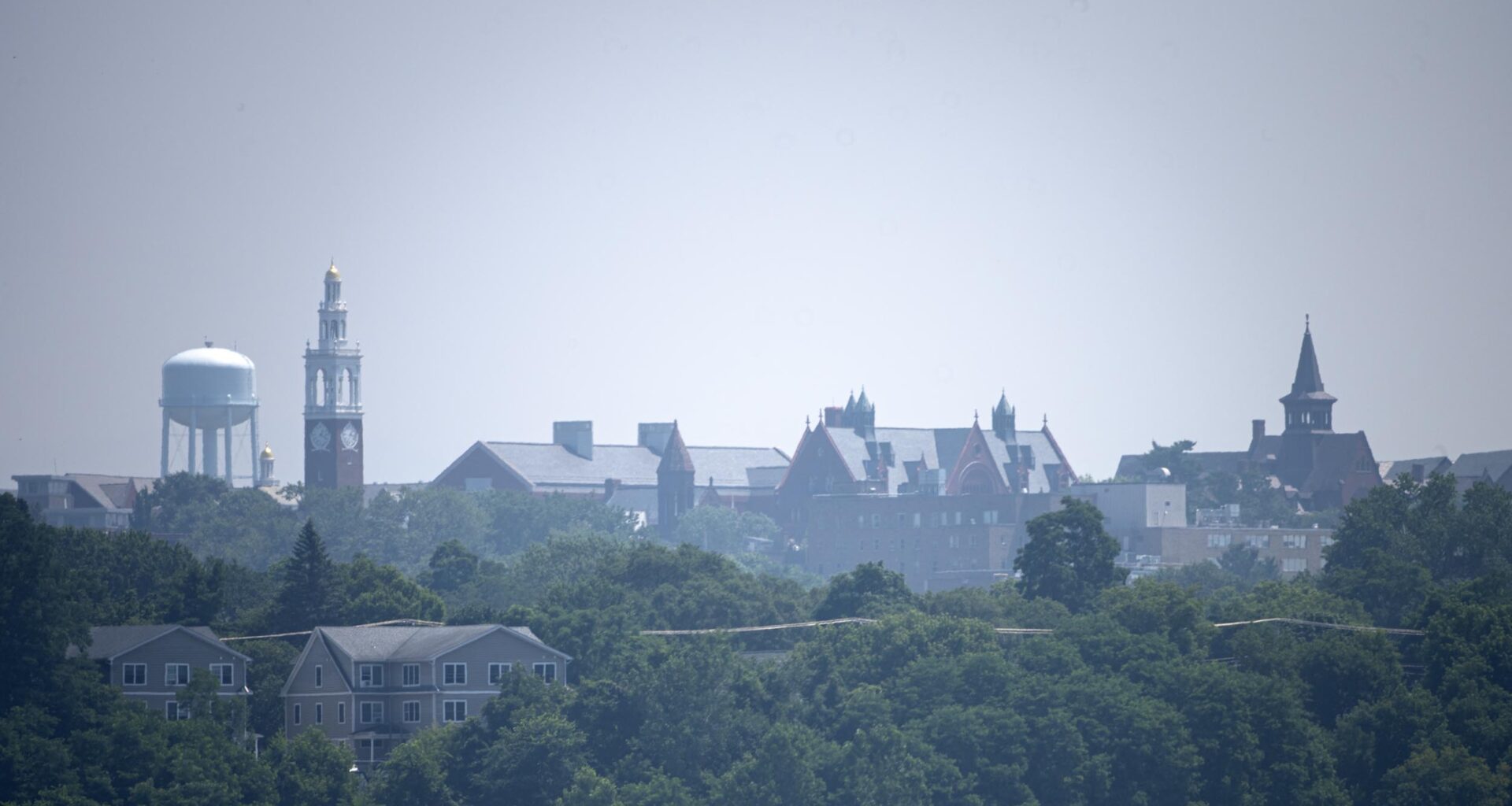 University of Vermont buildings and others are seen through haze in a view from the beltline in Burlington on Tuesday, July 15. Photo by Glenn Russell/VTDigger
University of Vermont buildings and others are seen through haze in a view from the beltline in Burlington on Tuesday, July 15. Photo by Glenn Russell/VTDigger
A wafting trail of Canadian wildfire smoke has blanketed Vermont, triggering air quality alerts across the state and causing a haze to block out its mountain views.
The National Weather Service issued a Code Orange air quality alert for Addison, Rutland and Windsor on Wednesday, a slight improvement from the statewide alerts on Monday and Tuesday.
Officials have urged Vermonters with health risks to be cautious. The Vermont Department of Environmental Conservation said in an emailed statement that wildfire smoke pollutants can cause an array of health effects.
To many Vermonters, the haze of recent days is reminiscent of 2023, when record-breaking wildfires in Quebec and Ontario sent smoke southward. To health officials, this latest string of alerts is the harbinger of a worrying trend.
“These recurrent episodes of wildfire smoke are a new and serious risk for Vermont air quality,” said David Grass, senior environmental health program manager at the state Department of Health.
Here are some details about the recent wildfires, what we know about the rise of air quality issues and how to protect your health.
Is Vermont’s air quality getting worse?
Historically, Vermont has been able to boast having some of the cleanest air in the nation. Burlington was once regularly ranked one of the “cleanest cities” by the American Lung Association for both ozone and particle pollution.
But it fell off the list in 2023 as particle pollution worsened, said Bennet Leon, planning section chief at the Department for Environmental Conservation.
Data from air quality monitoring stations at three state sites seems to show that there’s been little change in air quality on average in winter, spring and fall. It’s the periods of acute pollution, like this week’s wildfire smoke, that seem to be worsening the overall air quality.
“We’ve definitely seen … a lot more wildfire smoke impacting Vermont in the last five years than we saw for a number of years prior,” Leon said.
At the same time, it can be hard to predict when, and how, wildfires could impact Vermont in the future.
“There are predictions with climate change that wildfires will increase, and their severity will increase, but it doesn’t mean that every year is going to be worse than the last,” he said. “There will still be variability from year to year.”
The department has aimed to help Vermonters understand that “dealing with wildfire smoke is going to be part of our future,” Grass said.
“We’re going to have to learn how to live with it,” he said. “And if we want to live with it and not have it adversely impact our health, then we have to figure out how to stay healthy in spite of it.”
How does wildfire smoke impact Vermonters’ health?
The primary pollutant from wildfire smoke is known as PM 2.5, or particulate matter that is 2.5 microns or less in diameter, Grass said. Compare that with the width of a human hair, which measures 50 to 120 microns.
Those small particles can pass into the bloodstream, causing inflammation that can lead to a broad range of symptoms — from irritated eyes and runny noses, to respiratory symptoms like coughing and asthma attacks, to cardiovascular symptoms like a rapid heartbeat and chest pain, Grass said.
He likened it to the “cumulative stress of, essentially, being a smoker when you’re a non-smoker.”
Those effects are more likely when you have health conditions that already affect those systems of your body, like heart disease or chronic obstructive pulmonary disease, according to the health department website. It can also impact children, older people and pregnant people more easily.
The health department has only recently begun to track the effects of wildfire smoke incidents on population health. In 2023, department data showed an uptick in emergency department and urgent care visits tied to COPD, Grass said.
In emerging research, air quality has also been linked to a variety of long-term health effects like premature births, worsening dementia symptoms and mental health issues, he said.
And poor air quality has delivered a hit to Vermonters’ overall well-being and quality of life in a state so reliant on outdoor recreation, he said.
“We have a short summer. It’s glorious, and we try to make the most of it,” Grass said. “And when the air quality is as bad as it is, and has been recently, that is a significant obstacle to us being able to take advantage of all of the wonderful opportunities outdoors.”
How can you protect yourself from wildfire smoke pollution?
The best way to protect yourself when air quality is poor is to simply stay inside with your windows and doors closed, according to the health department’s website. It suggests avoiding outdoor activity or limiting it to a shorter duration.
Grass acknowledged that may be more difficult for some Vermonters than others. In a state with relatively low access to air conditioning, sealing yourself off from air flow could also make it more difficult to keep your home cool, he said, potentially creating “a dangerous situation inside.”
The department has a map of cooling sites on its website, some of which have air conditioning.
An air filter or purifier can provide an additional layer of protection during very poor air quality days, but that is a “new ask” for Vermonters, he said.
“Especially when all the other expenses in their lives are challenging, saying that it’s a good idea to buy an air filter or air purifier of some kind feels like it’s asking a lot,” Grass said.
If you do have to go outside, the department recommends wearing an N95 mask, limiting strenuous activity and planning activities for the morning or evening when pollution levels are lower.
Grass said it could help to avoid doing things that create even more air pollution, like idling your car, burning yard debris or even cooking something like meat at high temperatures.
“There’s been days where there’s bad air quality outside, and I’m making breakfast for my kids, and I think, ‘Yeah, sausage seems like a great idea,’” he said. “I have an air quality monitor, and I see it go from green into yellow.”
He noted that some Vermonters are at higher risk because they have no choice but to spend time outside. That includes people who work outdoors daily.
“Someone who is a farmworker, or works on a road crew — they’re going to have a very different exposure than someone who spends most of their time inside,” he said.
And the state’s unhoused population, particularly its growing number of people without any shelter, have few options for retreating indoors, he said.
“Those folks are at increased risk because they are going to be exposed to the wildfire smoke 24 hours a day when they’re not inside in a clean air environment,” Grass said. “I feel like that group of unhoused people are frequently overlooked, and that it’s important to keep their welfare in mind, particularly on those days when it’s extremely hot out, or when the air quality is really poor.”

